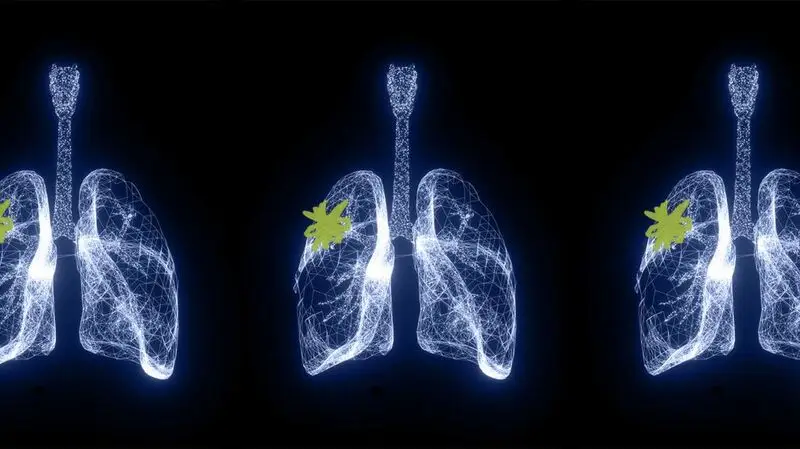
- About 1.8 million deaths each year are attributable to lung cancer, making it the leading cause of cancer death around the world.
- Only 16% of people with lung cancer receive an early diagnosis, which offers a much higher survival rate.
- Researchers say they have developed a new way to detect lung cancer at its earliest stages using an inhaler and a simple urine test.
About
Previous research reports that
However, as with any type of cancer, an
Now, researchers from the Massachusetts Institute of Technology (MIT) say they have developed a new way to detect lung cancer at its earliest stages using an inhaler and a simple urine test.
The study was recently published in the journal Science Advances.
Current guidelines recommend anyone between the ages of 55 and 80 years old who has a history of heavy smoking should be screened for lung cancer.
Right now, the gold standard for lung cancer screening is the low-dose computed tomography (CT) scan. However, CT scans can sometimes produce
Past research shows that the
“Lung cancer is such a difficult diagnosis for many patients because it doesn’t give us many warning signs before it’s at an advanced stage,” explained Dr. Michael Spallone, a thoracic surgeon with Hackensack University Medical Center in New Jersey who was not involved in this study. “In fact, many of the lung cancers we diagnose on a day-to-day basis is based off of incidental findings; in other words, the patient has had imaging done for another reason, i.e. chest pain or cough, that just so happened to pick up an unrelated finding of a lung nodule or mass.”
“Many lung cancers can be cured if detected early, particularly with
For this study, researchers used a new technology using
The nanoparticle sensors are coated with a reporter, such as a DNA barcode, making them into “nano-detectives” for lung cancer screening, said Qian Zhong, a research scientist at MIT and co-lead author of this study.
“Upon inhalation, these DNA-barcoded nanoparticles patrol the lungs in search of cancer-associated
“We analyze these urinary ‘fingerprints’ using a multiplexed quantitative lateral flow assay,” he added. “Results can be obtained at room temperature from the paper test within 20 minutes.”
As access to CT scans is limited in certain parts of the world, scientists believe this inhaler screening test may provide another option.
“CT remains one of the best imaging modalities with high resolution to visualize malignant nodules when substantial respiratory symptoms associated with lung cancer have been spotted or developed,” Dr. Edward Tan, a former postdoctoral research fellow at MIT and co-lead author of this study, explained to Medical News Today. “However, up to 95 percent of CT-positive patients are false positive. For those early nodules that cannot be confirmed benign or malignant in a single visit or are located in deep lung areas, one or more CT scans in (the) following months or years are needed for confirmation. Unfortunately, many patients in reality don’t follow the recommendations or miss the follow-up appointments.”
“The whole process is costly and always completed in several visits, which is definitely [a burden] to low-income households which live pay check by pay check,” Tan added. “Therefore, many at-risk people from low-income households have limited/no access to this lung cancer program even in the U.S., not to mention in other low-income countries. So we believe that the accessibility to this kind of screening could have a big impact in those contexts.”
This new lung cancer screening test was tested on a mouse model during this study. The mice were genetically engineered to develop lung tumors similar to those seen in humans.
Through various experiments, scientists measured the levels of 20 different sensors, ultimately identifying four required sensors for diagnostic results. These four sensors were tested again in the mouse model and researchers reported it could accurately detect early-stage lung cancer tumors.
The research team reportedly plans to next test the sensors on human biopsy samples and eventually perform clinical trials on humans.
“We are actively exploring the platform’s utility for detecting other pulmonary diseases, such as infections,” Tan said. “Another exciting application of the PATROL platform is therapeutic monitoring. For instance, it could serve as a tool to assess patients’ responses to specific treatments. Regarding translation to clinical use, further optimization of the nanosensor probes and extensive preclinical studies are required.”
After reviewing this study, Spallone told MNT that this type of technology and innovation is so exciting to see.
“It’s part of the reason that many of us choose to go into medicine in the first place,” he said. “Medicine is constantly changing, adapting, and improving. In the cancer world, particularly lung cancer, the name of the game is early detection. Anything that gets us an earlier diagnosis has the potential to improve outcomes for patients.”
“The other aspect that I love is the ease of the proposed test,” Spallone added. “Many patients are familiar with using an inhaler and a urine test is one of simplest diagnostic tools available for patients. It doesn’t involve needles or radiation such as an X-ray or CT scan. Any time you can simplify testing and make it safe, patients tend to be more comfortable taking advantage of it.”
Spallone commented that the obvious next step for this type of research is to test its effectiveness in humans.
“The article highlights the fact that human lung cancer is more complicated than the mouse models it was initially tested on,” he explained. “You want to make sure the test is sensitive — it knows when cancer is there — and you want it to be specific — it knows that it’s cancer and not something else. This often takes time and meticulous effort on the part of the research team. That being said, I have a lot of optimism that it could become a more attractive and available option to those appropriate for lung cancer screening in (the) future.”





